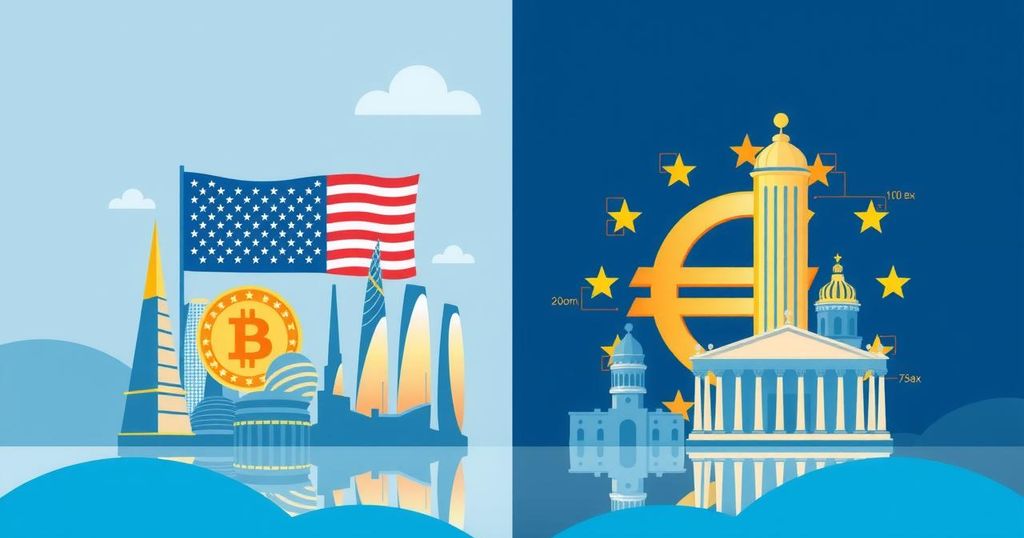Contrasting Digital Asset Policies: US vs. EU in 2025
As of 2025, the EU and US approach digital asset regulation differently. The EU’s MiCAR regulation, effective December 2024, establishes comprehensive oversight aimed at financial stability and consumer protection. Conversely, the US faces a fragmented regulatory landscape with shifting strategies that prioritise blockchain innovation while opposing CBDCs. The outcomes of these differing approaches may significantly influence global market dynamics and could prompt calls for harmonisation between these two major economies.
The 2025 crypto policy landscape reveals contrasting approaches between the United States and Europe, reflecting differing priorities amid pressures on the US dollar and Europe’s economic sovereignty ambitions. As EU regulations like the MiCAR establish a comprehensive framework for digital assets, the US struggles with a fragmented regulatory environment, potentially impacting global market dynamics.
The European Union (EU) implemented its digital currency regulation, known as MiCAR, on December 30, 2024. MiCAR, in conjunction with the Transfer of Funds Regulation and the Digital Operational Resilience Act, imposes strict bank-like regulations on stablecoins and cryptocurrencies. This framework aims to enhance financial stability and consumer protection while centralising oversight of cryptocurrencies mined outside the EU, particularly amidst concerns highlighted by the European Central Bank regarding US crypto markets.
MiCAR covers the issuance and trading of crypto assets, necessitating compliance with rigorous internal risk management and capital requirements for companies. E-money issuers must adhere to licensing requirements under the Second Electronic Money Directive. Despite accompanying challenges, this regulation provides crucial legal certainty for the developing EU crypto sector, fostering its growth and compliance.
In contrast, the US crypto policy from 2021 to 2024 has seen significant fluctuations, influenced by market volatility and regulatory challenges. The shift from initial support for crypto and Central Bank Digital Currencies (CBDCs) to a stringent regulatory approach raises concerns about illicit activities and financial stability risks. Recent bipartisan efforts to regulate stablecoins highlight the ongoing complexity of US regulatory processes as conflicts persist in Congress.
The new administration’s executive order indicates a divergence from the EU’s stance, favouring blockchain while opposing CBDCs, citing risks to privacy and financial system stability. This pro-blockchain approach reinforces the need for a coherent US framework, elevated at the White House level, to address issues within the digital asset market and to protect consumer interests, as highlighted by Congress and regulatory bodies alike.
Opportunities for regulatory alignment between the EU and the US exist but will require overcoming substantial differences. While MiCAR may offer competitive advantages for the EU, recent US initiatives could prompt harmonisation, particularly regarding compliance with the Bank Secrecy Act. However, true transatlantic regulatory convergence appears unlikely, given historical disparities in financial regulatory practices.
Currently, US crypto entities dominate European markets, as evidenced by reports indicating that USD-backed stablecoins make up a significant portion of market volume in Europe. This disparity raises concerns that potential regulatory clarity in the US could enhance its global crypto dominance, pressuring EU policymakers to align more closely with American standards, despite the challenges posed by existing regulations like MiCAR.
Furthermore, structural issues such as the distributed nature of blockchain and discrepancies between MiCAR and US Bank Secrecy Act requirements indicate potential friction in regulatory enforcement. As the US grapples with its financial stability amidst recent banking sector crises, European policymakers favour extending banking regulations to mitigate associated risks and support a regional CBDC initiative.
Despite the anticipated regulatory divergences, both the EU and the US are focusing on their unique sets of priorities, underscoring the complexity of global digital asset governance. The contrasting policies express a broader tension in international finance, highlighting the intricate balance of promoting innovation while managing systemic risks in the evolving cryptocurrency landscape.




Post Comment